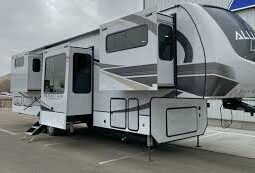Tornado RV safety
3 min readIf you live in a region that may be in the path of a tornado, you should have a plan to ensure your family’s safety. Such a plan should involve preparing for the storm’s full force as well as the best location to ride it out. The preparation can start as early as the NOAA “Tornado Advisory” announcement, but definitely immediately upon an upgrade to a “Tornado Warning.”
Unlike a tornado safety plan for your home, a plan for your RV on the road, may vary widely. Much will depend on your location and environmental surroundings. The danger here is usually far greater than that of being at home in familiar surroundings.
So, let’s look at the best practices for such an event.
Best practices for a tornado
Image via Shutterstock
Check the forecast
First, like a mariner or pilot, a weather forecast check should be made for the area of your travel path. Apps from The Weather Channel, AccuWeather, and WeatherBug are all highly rated, trusted, and accessible on any mobile device.
Seek shelter nearby
If the possibility of any violent weather may exist, then staying put in the RV park may be wise. Shelter for a tornado, or like weather, in most campgrounds generally can be found in hard-shell buildings like clubhouses, washrooms, etc. Whether on the road or in camp, do not stay in the RV if a hard shell building is available or if a lower ground elevation is near. (Deep ditch, low laying field, etc.)
What if no safe shelter is available?
Tornados travel at about 35 to 45 miles per hour. While it is possible to outrun one if you can drive directly away from them, it may not be the safest idea. Even if you can stay ahead, the unstable weather conditions may spawn new vortexes in your path without warning.
Should you be caught on the road, do not park beneath an overpass. These usually experience higher wind speeds caused by their geographic profile.
If in a truck/trailer combination, shelter only in the truck. With seat belts fastened, keep heads low below the window level and cover with blankets or protective covers.
If in a motorhome, move away from the front to an area away from windows. Wear seat belts and cover your head with blankets, pillows, etc.
Stay sharp
In all cases, once the storm has passed, check the radio for weather updates. Be very aware of possible fallen electrical wires, trees and any other foreign debris.
Your chances of one day being exposed to such a violent weather event may be higher than you think. There are about 1,200 tornados each year in the U.S. The majority are during the heat of summer, when the number of RV’s on the road are at the highest.
So, be prepared. If you don’t already have an automatic NOAA radio, get one. Form a basic emergency plan and make all family members aware of where the emergency exist(s) are and how they work.
Awareness and planning can turn what may be an ordeal into an experience of the fury of Mother Nature.
Don’t get caught off-guard
No matter how prepared you are, an emergencies still happen when you least expect them. Good Sam Travel Assist covers the gap from coordinating emergency medical transportation, returning your RV after an incident, or even making sure your pets get taken care of.
The post Tornado RV safety appeared first on Good Sam Camping Blog.



